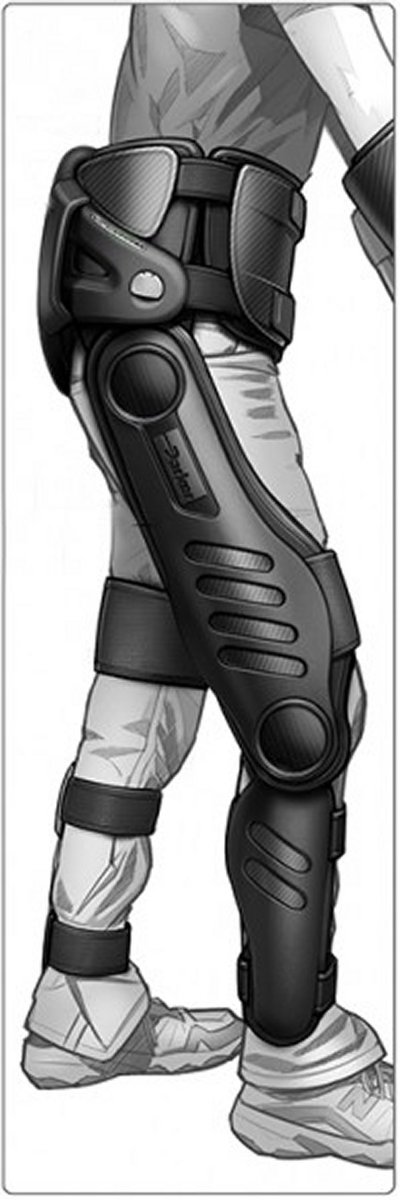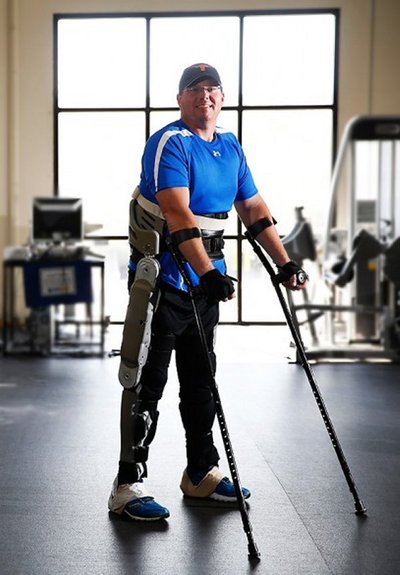Advanced exoskeleton promises more independence for people with paraplegia
Until recently, ‘wearable robots’ were the stuff of science fiction. In the last 10 years, however, advances in robotics, microelectronics, battery and electric motor technologies have advanced to the point where it has become practical to develop exoskeletons to aid people with disabilities.
In fact, two companies - Argo Medical Technologies Ltd in Israel and Ekso Bionics in Berkeley, Calif. - have developed products of this type and are marketing them in the US. Now, a team of engineers at Vanderbilt University’s Center for Intelligent Mechatronics has developed a powered exoskeleton that enables people with severe spinal cord injuries to stand, walk, sit and climb stairs. Its light weight, compact size and modular design promise to provide users with an unprecedented degree of independence.
The university has several patents pending on the design and Parker-Hannifin Corporation - a global leader in motion and control technologies - has signed an exclusive licensing agreement to develop a commercial version of the device, which it plans on introducing in 2014.
“You can think of our exoskeleton as a Segway with legs,” said Michael Goldfarb, the H. Fort Flowers Chair in Mechanical Engineering and professor of physical medicine and rehabilitation. “If the person wearing it leans forward, he moves forward. If he leans back and holds that position for a few seconds, he sits down. When he is sitting down, if he leans forward and holds that position for a few seconds, then he stands up.
“We have seen some significant improvements in robotics technology and mechatronics technology over the last five years, and they have enabled this,” said Goldfarb.
Some of the major stepping stones in the rise of the exoskeletons include the rare-earth magnet brushless motors, the overall quality and capability of microprocessors, and the high-power electronics that drive the motors in ultracompact devices.

“In addition, the US government invested a lot of money in microelectromechanical systems (MEMS) and, in particular, multiaxis accelerometers and gyroscopes that we’re incorporating into exoskeletons. We’re using high-quality MEMS sensors that only became available a couple of years ago.”
The automobile industry’s hybrid and electric-car programs pitched in as well, by helping advance battery development.
“There’s been a confluence of a lot of important technologies that were not available a decade ago, so exoskeletons were not possible until now.”
These devices act like an external skeleton. They strap in tightly around the torso. Rigid supports are strapped to the legs and extend from the hip to the knee and from the knee to the foot. The hip and knee joints are driven by computer-controlled electric motors powered by advanced batteries.
The Vanderbilt exoskeleton includes motors at the hip and knee joints and incorporates all of the robotic controls, customised electronics and batteries within the device. “The machinery is in the two thighs, the battery is in the hip piece and it all talks to one another through a communication circuit within the device. So we also didn’t need the backpack that some of the other devices have,” Goldfarb said. This design puts most of the weight of the device at the hip and eliminates any weight from the shoulders. Patients use the powered apparatus with walkers or forearm crutches to maintain their balance.
Goldfarb developed the system with funding from the National Institutes of Health and with the assistance of research engineer Don Truex, graduate students Hugo Quintero, Spencer Murray and Kevin Ha, and Ryan Farris, a former student who now works for Parker Hannifin.
“My kids have started calling me ‘Ironman’,” said Brian Shaffer, who was completely paralysed from the waist down in an automobile accident on Christmas night 2010. He has been testing the Vanderbilt apparatus at the Nashville-area satellite facility of the Shepherd Center. Based in Atlanta, Shepherd Center is one the leading hospitals for spinal cord and brain injury rehabilitation in the US and has provided the Vanderbilt engineers with the clinical feedback they need to develop the device.
“It’s unbelievable to stand up again. It takes concentration to use it at first but, once you catch on, it’s not that hard: the device does all the work. I don’t expect that it will completely replace the wheelchair, but there are some situations, like walking your daughter down the aisle at her wedding or sitting in the bleachers watching your son play football, where it will be priceless,” said Shaffer, who has two sons and two daughters.

“This is an extremely exciting new technology,” said Clare Hartigan, a physical therapist at Shepherd Center who has worked with the Argo, Ekso and Vanderbilt devices. “All three models get people up and walking, which is fantastic.”
According to Hartigan, just getting people out of their wheelchairs and getting their bodies upright regularly can pay major health dividends. People who must rely on a wheelchair to move around can develop serious problems with their urinary, respiratory, cardiovascular and digestive systems, as well as getting osteoporosis, pressure sores, blood clots and other afflictions associated with lack of mobility. The risk for developing these conditions can be reduced considerably by regularly standing, moving and exercising their lower limbs.
The Vanderbilt design has some unique characteristics that have led Hartigan and her colleagues at Shepherd Center to conclude that it has the most promise as a rehabilitative and home device.
None of the exoskeletons have been approved yet for home use. But the Vanderbilt design has some intrinsic advantages. It has a modular design and is lighter and slimmer than the competition. As a result, it can provide its users with an unprecedented degree of independence. Users will be able to transport the compact device on the back of their wheelchair. When they reach a location where they want to walk, they will be able to put on the exoskeleton by themselves, without getting out of the wheelchair. When they are done walking, they can sit back down in the same chair and take the device off or keep it on and propel the wheelchair to their next destination.
The Vanderbilt exoskeleton weighs about 12 kg, nearly half the weight of the other models. The other models are also bulkier so most users wearing them cannot fit into a standard-sized wheelchair.
From a rehabilitation perspective, the Vanderbilt design also has two potential advantages, Hartigan pointed out:
- The amount of robotic assistance adjusts automatically for users who have some muscle control in their legs. This allows them to use their own muscles while walking. When a user is totally paralysed, the device does all the work. The other designs provide all the power all of the time.
- It is the only wearable robot that incorporates a proven rehabilitation technology called functional electrical stimulation. FES applies small electrical pulses to paralysed muscles, causing them to contract and relax. FES can improve strength in the legs of people with incomplete paraplegia. For complete paraplegics, FES can improve circulation, change bone density and reduce muscle atrophy.
There is also the matter of cost. The price tags of other rehabilitation model exoskeletons have been reported to be as high as $140,000 apiece, plus a hefty annual service fee. Parker Hannifin hasn’t set a price for the Vanderbilt exoskeleton, but Goldfarb is hopeful that its minimalist design combined with Parker Hannifin’s manufacturing capability will translate into a more affordable product. “It would be wonderful if we could get the price down to a level where individuals could afford them and insurance companies would cover them,” he said.
Meanwhile, Hartigan has advice for potential users: “These new devices for walking are here and they are getting better and better. However, a person has to be physically fit to use them. They have to keep their weight below 100 kg, develop adequate upper body strength to use a walker or forearm crutches and maintain flexibility in their shoulder, hip, knee and ankle joints … which is not that easy when a person has relied on a wheelchair for months or even years.”
Craig Maxwell, Parker vice president of technology and innovation, said the company’s decision to commercialise the medical device was part of a strategy to show off its technical leadership in motion and control technologies. And what could show off those capabilities more than restoring a person’s ability to walk.
New haptic patch transmits complexity of touch to the skin
The device, developed by researchers at Northwestern University, delivers various sensations,...
Stretchy gel sensor detects solid-state skin biomarkers
Researchers have developed a wearable, stretchable, hydrogel-based sensor that detects biomarkers...
Ultra-thin fibres can turn clothes into wearable electronics
Researchers have developed ultra-thin semiconductor fibres that can be woven into fabrics,...






